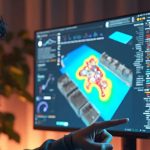Spatial computing represents an innovative approach to human-machine interaction, where digital experiences seamlessly merge with the physical environment. This groundbreaking technology enables a symbiotic relationship between reality and the digital realm, orchestrated by machines.
While IoT devices and smart speakers provide a glimpse into this concept, mixed reality stands at the forefront of technological advancements in spatial computing. Big technology companies have taken note of the promise of this type of technology, evidenced by the recent product announcement of Apple’s Vision Pro wearable. The announcement is evidence to the contrary, this immersive integration of digital elements within our physical world offers a profoundly human-centric experience.
The evolution of human-computer interaction
Throughout history, our interactions with technology have been mediated through screens, acting as windows into the virtual realm. These experiences, though evolving and improving, have remained grounded in the metaphor of observing a digital world from afar. However, spatial computing revolutionizes this paradigm by seamlessly blending the digital and physical worlds, offering humans a more natural and immersive experience. The objective is to prevent distractions and allow users to engage with the digital content while maintaining a solid connection to their physical surroundings. This augmented experience promotes efficiency, safety, and an inherently human way of interacting with machines.
The human-centric potential of spatial computing
Spatial computing brings a new era of human-machine interaction, where the digital world becomes an integrated and meaningful part of our everyday lives. By seamlessly embedding digital experiences into our physical environment, spatial computing aims to enhance our experiences and facilitate more efficient task completion. Imagine being able to interact with digital content using natural gestures and movements without the need for external controllers. This level of immersion and interaction can make technology an organic extension of ourselves, leading to a more intuitive and human-centric experience.
Apple’s Vision Pro implementation
Apple’s Vision Pro implementation is a compelling example of the critical aspects and priorities within spatial computing. Apple has introduced a unique technology that pushes the boundaries of what was previously thought possible. Their emphasis lies in optimizing critical elements for a superior user experience. Notably, eye tracking plays a pivotal role by enabling the device to determine where the user is looking regarding coordinates and depth perception, eliminating the need for conventional controllers, and allowing users to interact directly with their hands. By focusing on these essential aspects, Apple has taken a significant step towards realizing a more seamless and immersive spatial computing experience.
The promise of mixed reality
Mixed reality emerges as a compelling alternative to fully rendered virtual reality in pursuing spatial computing. From a technological standpoint, fully realized virtual worlds can pose immense complexity, particularly regarding inclusion and usability. However, mixed reality strikes a balance by integrating digital elements into the physical environment, making it a practical enhancement to everyday life. Though not without challenges, this approach has significant potential for transforming our everyday experiences and reshaping our communication with machines. As we move forward, it is evident that spatial computing will render our existing knowledge and practices obsolete, and the pace at which this transformation unfolds remains to be seen.
The way forward
Spatial computing represents a groundbreaking evolution in human-machine interaction, seamlessly blending digital experiences with our physical surroundings. By breaking free from the metaphor of screens and windows into the virtual world, spatial computing offers a more intuitive and human-centric way of engaging with technology. Apple’s Vision Pro implementation showcases the possibilities within this field, emphasizing critical aspects such as eye tracking and hands-on interaction. As we embark on this new era of mixed reality experiences, spatial computing holds the potential to reshape our lives and communicate with machines in profound ways. The future awaits, and only time will reveal the speed at which these transformative changes occur.
Globant helps clients create a way forward for making emerging technologies approachable and usable. Learn more about our approach to phygital in this recent Unscripted Tech podcast episode, “How smart venues are reinventing brand experiences,” featuring Globant’s CTO Europe, Martin Nanni.




